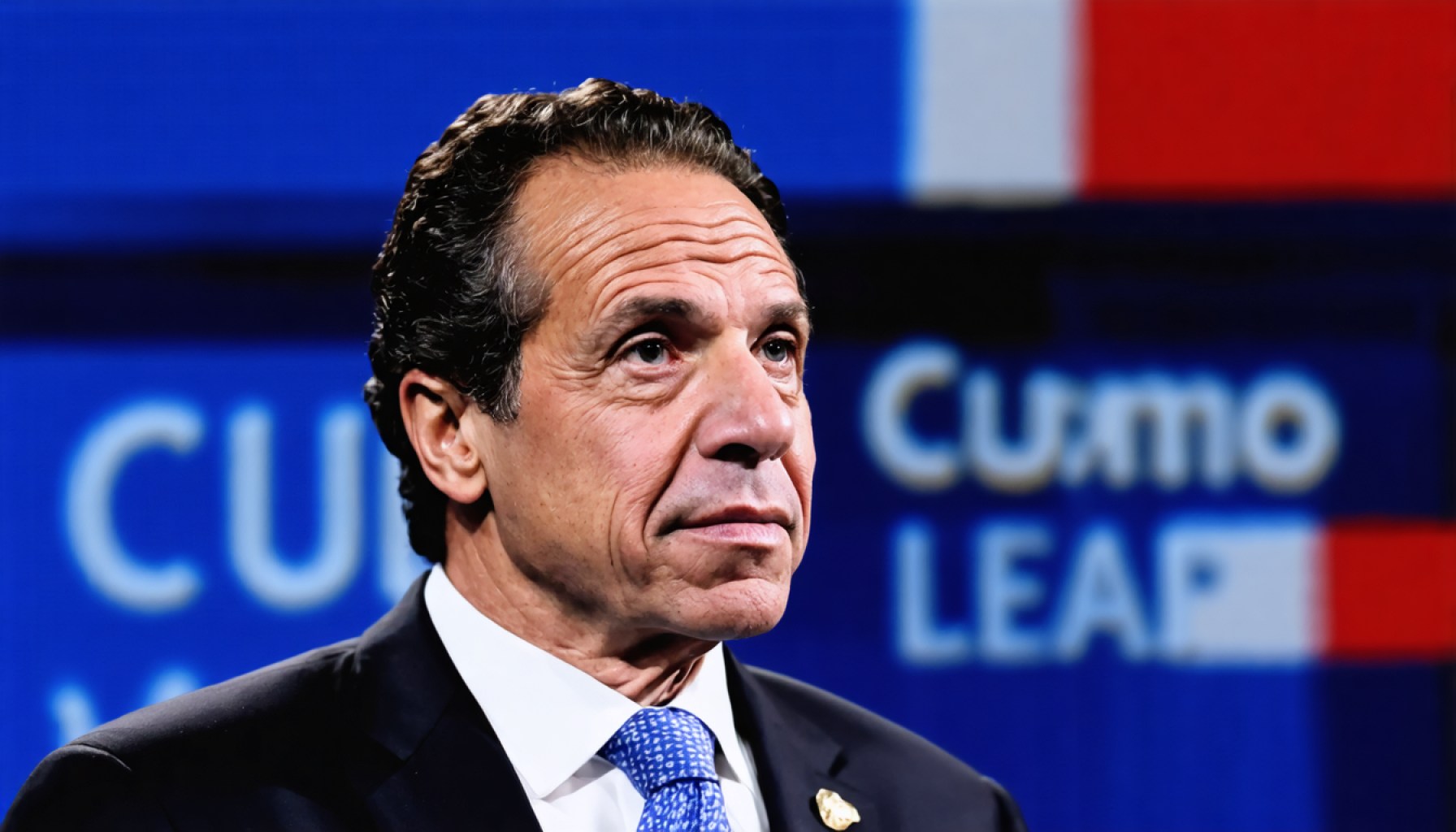
This image was generated using artificial intelligence. It does not depict a real situation and is not official material from any brand or person. If you feel that a photo is inappropriate and we should change it please contact us.
Andrew Cuomo’s Fragile Lead: The Illusion of Name Recognition in the NYC Mayoral Race
- Andrew Cuomo is a leading candidate for the 2025 New York Mayor race, but his position is unstable.
- Mayor Adams’s 67% unfavorable rating highlights voter dissatisfaction, creating opportunities for challengers.
- Cuomo’s mixed favorability (45% favorable, 47% unfavorable) presents both advantages and challenges.
- Lesser-known candidates like Scott Stringer (37% favorable) show potential with positive public perception.
- Cuomo’s lead could fade due to controversies and skepticism surrounding his past actions.
- His vulnerabilities are significant among Black and Latino working-class voters, offering openings for opponents.
- Name recognition benefits Cuomo now, but substance and trust will ultimately decide the race.
Andrew Cuomo enjoys the limelight once again, emerging as a frontrunner for the 2025 New York Mayor race. Yet, a closer look reveals a precarious lead, more akin to a house of cards than a fortress. Such dynamics in political races aren’t novel; in fact, history reminds us of Andrew Yang’s short-lived surge in a previous mayoral race.
New Yorkers are in a pensive mood, yearning for genuine change. Mayor Adams faces significant discontent, with a staggering 67% unfavorable rating, leaving potential challengers eying his vulnerable position. Cuomo, with his storied past and mixed favorability ratings (45% favorable vs. 47% unfavorable), finds himself both blessed and burdened by his notoriety.
Strong winds of skepticism swirl as lesser-known contenders like Scott Stringer and Jessica Ramos begin to navigate the shadowy alleys of political anonymity. Their relatively positive public perceptions hint at a promising path if they can amplify their presence. Scott Stringer, for instance, carries a notable 37% favorable rating against a mere 21% unfavorable—a stark contrast to Cuomo’s numbers.
While Cuomo currently basks in his initial 31% lead, this edge could diminish rapidly. Name recognition can be a double-edged sword. His support falters when voters, reminded of controversies—ranging from mishandling COVID data to distressing allegations—shift uneasily.
Cuomo’s vulnerabilities are particularly pronounced within his base—Black and Latino working-class voters. These fissures provide fertile ground for opponents to till, potentially recalibrating the race.
The stakes are high, but the narrative is clear: name recognition may light the path, but substance and trust will determine who ultimately enters City Hall. New Yorkers, in their quest for change, hold the power to rechart this course.
Could Andrew Cuomo Really Be NYC’s Next Mayor? Behind the Headlines and What’s at Stake
Insights Into the New York Mayoral Race
The political scene in New York City is buzzing with speculation as Andrew Cuomo re-emerges as a potential candidate for the mayoral race in 2025. While his lead seems substantial at face value, history warns us of its fragility amidst controversy and past performance.
How-To Steps & Life Hacks for Aspiring Political Candidates
1. Leverage Name Recognition: Candidates with existing public recognition, like Andrew Cuomo, can capitalize on their notoriety. However, they must swiftly pivot to address and mitigate past controversies.
2. Engage with Core Constituencies: Address concerns within vital voter groups such as Black and Latino communities. Tailored messaging and community-based initiatives can significantly bolster support.
3. Amplify Lesser-Known Candidates: For candidates like Scott Stringer and Jessica Ramos, establishing a strong presence through grassroots campaigns and social media can effectively raise their profile.
Real-World Use Cases of Political Comebacks
– Richard Nixon: Despite a turbulent past, Nixon successfully re-entered political prominence and eventually became President.
– Joe Biden: Overcoming past obstacles and controversies, Biden reemerged victorious in his presidential run, highlighting resilience and adaptability.
Market Forecasts & Industry Trends
The race highlights a broader trend of political re-emergence, where known figures attempt comebacks by strategically altering public perception. As public trust in political figures wanes globally, candidates must exhibit transparency and accountability, leveraging digital platforms to maintain voter engagement.
Reviews & Comparisons
– Andrew Cuomo vs. Other Contenders: Cuomo’s mixed approval ratings present a unique challenge compared to his rivals, who possess less notoriety but potentially more positive public perception.
– Performance vs. Perception: Cuomo’s known performance in office contrasts sharply with contenders who are perceived positively but lack extensive public office experience.
Controversies & Limitations
Cuomo’s past is riddled with issues, including the handling of COVID-19 data, which continues to cast a shadow over his campaign. Critics argue that these controversies could undermine trust and hamper his path to City Hall.
Features, Specs & Pricing of a Campaign
Running a successful campaign involves strategic resource allocation:
– Budgeting for Media and Publicity: Candidates like Cuomo have the advantage of media attention, but lesser-known candidates need significant investment in advertising.
– Establishing a Grassroots Network: On-the-ground campaigning is crucial for direct voter engagement, demanding a robust budget.
Security & Sustainability in Campaigning
Ensuring data security in voter engagement platforms is critical. Sustainable campaigning practices, such as digital rallies and reducing waste, are gaining traction and appeal to environmentally conscious voters.
Pros & Cons Overview
Pros:
– Name recognition can be a powerful tool.
– Experience in public office provides a clear track record.
Cons:
– Past controversies can dominate the narrative.
– Shifting public expectations demand adaptation and transparency.
Actionable Recommendations
1. Acknowledge and Address Past Mistakes: Directly address controversies with clarity and propose actionable remedies.
2. Build a Diverse Campaign Team: Engage diverse voices to resonate with a broad electorate.
3. Utilize Digital Platforms: Leverage social media for continuous engagement and real-time feedback from constituents.
In conclusion, the path to City Hall is fraught with challenges, both old and new. While Cuomo stands in the limelight today, the crux of the race will hinge on authenticity and building trust with New Yorkers. Aspiring candidates or voters seeking more insight can explore platforms such as New York Post for daily updates and in-depth analysis.